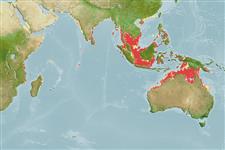Classification / Names
Common names from other countries
Main reference
Size / Weight / Age
Max length : 64.0 cm TL male/unsexed; (Ref. 6006); common length : 50.0 cm TL male/unsexed; (Ref. 5450); max. published weight: 9.0 kg (Ref. 1468)
Length at first maturity
Lm ?, range 37 - 39 cm
Environment
Marine; demersal; depth range 1 - 100 m (Ref. 9792), usually 20 - 50 m (Ref. 9792)
Climate / Range
Tropical, preferred 28°C (Ref. 107945); 26°N - 21°S, 43°E - 156°E (Ref. 54739)
Distribution
Short description
Dorsal
spines
(total): 9 - 11;
Dorsal
soft rays
(total): 38-45;
Anal
spines: 1;
Anal
soft rays: 33 - 43;
Vertebrae: 23 - 25. Body oval and flat, but thicker than in most other flatfishes. Mouth large with strong teeth; maxillary extends well beyond hind edge of lower eye; both eyes on left or right side; upper eye lying immediately below dorsal edge; gill rakers not developed. Dorsal fin origin well posterior to eyes; anterior fin rays spinous; lateral line almost straight. Color usually brown or grey, sometimes with 4 broad, dark crossbars. Dorsal, anal and caudal fin tips black. Blind side occasionally partially colored. (Other sources of morphological data: Refs. 591, 529, 4416, 5997 and 6000).
IUCN Red List Status (Ref. 115185)
Threat to humans
Harmless
Human uses
Fisheries: commercial
Tools
Special reports
Download XML
Internet sources
Estimates of some properties based on models
Phylogenetic diversity index
PD50 = 0.7500 many relatives (e.g. carps) 0.5 - 2.0 few relatives (e.g. lungfishes)
Trophic Level
4.4 ±0.3 se; Based on diet studies.
Resilience
Medium, minimum population doubling time 1.4 - 4.4 years (K=0.26-0.38; tm=3-4; Fec=300,000)
Vulnerability
Low to moderate vulnerability (29 of 100)
Price category
